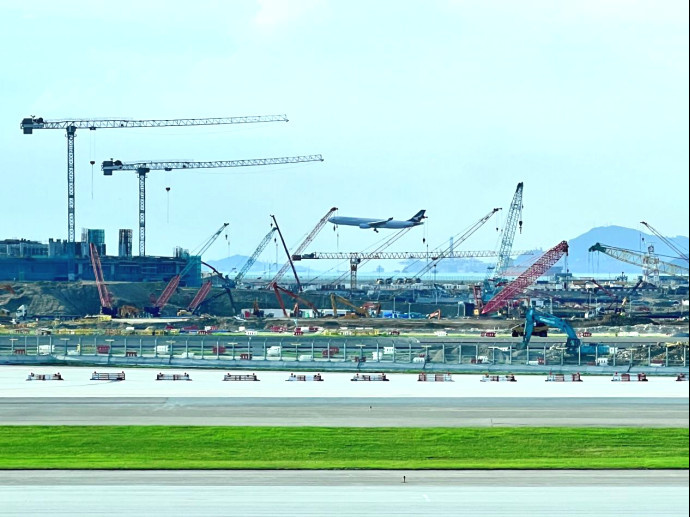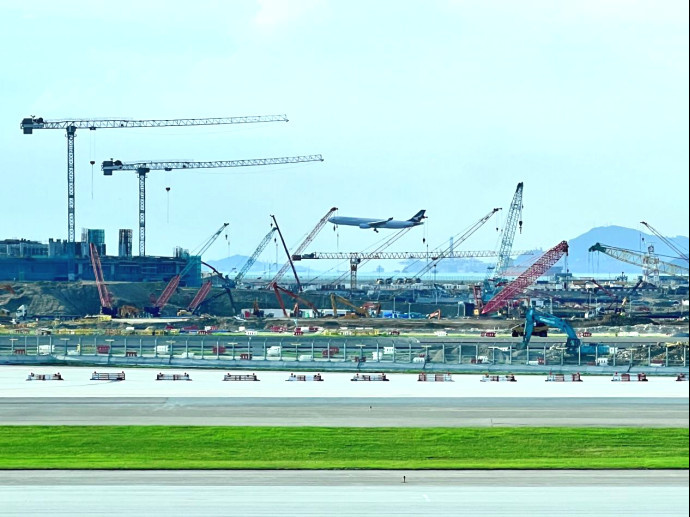By Wang Lingxi

The supporting projects of the third runway of Hong Kong International Airport is under construction, June 10, 2023. (Photo by Liu Jili/People's Daily Online)
In 2023, the cumulative passenger traffic at the airports in the Guangdong-Hong Kong-Macao Greater Bay Area (GBA) reached approximately 180 million people, and various indicators such as flight frequencies and cargo throughput have fully recovered.
In particular, Hong Kong International Airport handled 39.5 million passengers, Guangzhou Baiyun International Airport 63 million, Shenzhen Bao'an International Airport 52.73 million, Zhuhai Jinwan International Airport 11.457 million, and Macao International Airport 5.15 million.
As the GBA sees faster and faster integrated development, air routes from the GBA are reaching every corner of the world. A world-class airport cluster is rapidly taking shape in the area.
With the launch of the "Fly-via-Zhuhai-Hong Kong" passenger transfer service, travelers arriving at Zhuhai Jinwan International Airport on the Chinese mainland can now travel via the Hong Kong-Zhuhai-Macao Bridge directly to Hong Kong International Airport, without needing to go through immigration procedures in Hong Kong.
Industry insiders predicted that the project is expected to serve around 500,000 passengers annually. Vivian Cheung Kar-fay, Chief Operating Officer of the Airport Authority Hong Kong, noted that the "Fly-via-Zhuhai-Hong Kong" service not only provides travelers with more options of international travel, but also fully utilizes the connectivity of the Hong Kong-Zhuhai-Macao Bridge.
In terms of logistics, Hong Kong has leveraged its position as an international shipping hub to establish new mechanisms for the flow of goods with various cities in the GBA.
In April of last year, the Dongguan-Hong Kong International Airport Logistics Park was officially launched, and it has since served over 300 foreign trade enterprises in the GBA, with a total import and export value exceeding 1.7 billion yuan ($239.99 million).
"The airport cluster in the GBA will further strengthen its integration and collaboration across air and ground operations in all aspects, based on the principles of complementary development, competitive cooperation and benign interaction. This will better facilitate the integrated development between the world-class airport cluster and urban clusters," said an official of the Shenzhen municipal bureau of transport.
Developed aviation transportation capacity and airport economy are one of the core growth drivers of world-class bay areas.
Currently, the GBA has seven transport airports with 11 runways, including three international aviation hubs - Hong Kong International Airport, Guangzhou Baiyun International Airport, and Shenzhen Bao'an International Airport.
Additionally, there are two trunk airports, Macao International Airport and Zhuhai Jinwan International Airport, as well as two feeder airports, Foshan Shadi Airport and Huizhou Pingtan Airport.
According to estimates by the International Air Transport Association, air travel demand in the GBA is expected to increase significantly by 2030. The projections indicate there will be 387 million passengers and 20 million tons of air cargo traveling through the area in 2030. However, the major airports in the GBA are already operating at or near full capacity.
To facilitate more frequent movement of people and goods in the GBA, multiple airports in the area are undergoing expansion and accelerated development. In the coming years, there will be significant progress and breakthroughs as these airports strive to meet the growing demand.
Hong Kong International Airport is set to commence operations of its three-runway system project this year, aiming to achieve an annual passenger throughput of 120 million people and an annual cargo volume of 10 million tons.
Meanwhile, Guangzhou Baiyun International Airport is currently undergoing its third-phase expansion project, with an expected completion in 2025. Once operational, it will have a terminal capacity of 140 million passengers and a cargo throughput capacity of 6 million tons.
Additionally, Shenzhen Bao'an International Airport is accelerating its third runway expansion project and is projected to reach an annual passenger throughput of 80 million people and a cargo throughput of 2.6 million tons by 2026.
According to statistics, the GBA will have seven transport airports with 17 runways by 2035, with passenger throughput reaching 420 million people and cargo throughput exceeding 20 million tons. A world-class airport cluster featuring high-quality development will be built there.
"The future demand for air passenger and cargo transportation in the GBA will only continue to grow. By leveraging their respective strengths and promoting coordinated development, mutual benefits and win-win outcomes can be achieved," said Cheung Kwok Law, senior research fellow at the Aviation Policy and Research Center, Chinese University of Hong Kong.
Hong Kong enjoys a significant geographical advantage. Departing from Hong Kong, passengers can reach major cities in the Asia-Pacific region within 4 hours and half of the world's population can be reached within five hours of flight.
Hong Kong International Airport has been recognized as the "best airport in China," "best airport in Asia," and "busiest cargo airport in the world" for times. Currently, around 120 airlines operate in Hong Kong, connecting to 220 destinations worldwide and providing crucial momentum for Hong Kong's economic growth.
Meanwhile, as the "land-sea-air" comprehensive transportation network in the GBA gets more and more developed, Hong Kong International Airport will further optimize its multimodal transport network and operations.
"We are more than just as an airport in Hong Kong. We will build ourselves into a crucial international aviation hub leveraging the advantages of being a gateway of the GBA," said Fred Lam Tin-fuk, CEO of the Airport Authority Hong Kong.
He further emphasized that Hong Kong will continue to strengthen cooperation and connectivity with other cities in the GBA, provide more and better travel options for passengers in the area, and attract more overseas investors and tourists to the area.
In particular, Hong Kong International Airport handled 39.5 million passengers, Guangzhou Baiyun International Airport 63 million, Shenzhen Bao'an International Airport 52.73 million, Zhuhai Jinwan International Airport 11.457 million, and Macao International Airport 5.15 million.
As the GBA sees faster and faster integrated development, air routes from the GBA are reaching every corner of the world. A world-class airport cluster is rapidly taking shape in the area.
With the launch of the "Fly-via-Zhuhai-Hong Kong" passenger transfer service, travelers arriving at Zhuhai Jinwan International Airport on the Chinese mainland can now travel via the Hong Kong-Zhuhai-Macao Bridge directly to Hong Kong International Airport, without needing to go through immigration procedures in Hong Kong.
Industry insiders predicted that the project is expected to serve around 500,000 passengers annually. Vivian Cheung Kar-fay, Chief Operating Officer of the Airport Authority Hong Kong, noted that the "Fly-via-Zhuhai-Hong Kong" service not only provides travelers with more options of international travel, but also fully utilizes the connectivity of the Hong Kong-Zhuhai-Macao Bridge.
In terms of logistics, Hong Kong has leveraged its position as an international shipping hub to establish new mechanisms for the flow of goods with various cities in the GBA.
In April of last year, the Dongguan-Hong Kong International Airport Logistics Park was officially launched, and it has since served over 300 foreign trade enterprises in the GBA, with a total import and export value exceeding 1.7 billion yuan ($239.99 million).
"The airport cluster in the GBA will further strengthen its integration and collaboration across air and ground operations in all aspects, based on the principles of complementary development, competitive cooperation and benign interaction. This will better facilitate the integrated development between the world-class airport cluster and urban clusters," said an official of the Shenzhen municipal bureau of transport.
Developed aviation transportation capacity and airport economy are one of the core growth drivers of world-class bay areas.
Currently, the GBA has seven transport airports with 11 runways, including three international aviation hubs - Hong Kong International Airport, Guangzhou Baiyun International Airport, and Shenzhen Bao'an International Airport.
Additionally, there are two trunk airports, Macao International Airport and Zhuhai Jinwan International Airport, as well as two feeder airports, Foshan Shadi Airport and Huizhou Pingtan Airport.
According to estimates by the International Air Transport Association, air travel demand in the GBA is expected to increase significantly by 2030. The projections indicate there will be 387 million passengers and 20 million tons of air cargo traveling through the area in 2030. However, the major airports in the GBA are already operating at or near full capacity.
To facilitate more frequent movement of people and goods in the GBA, multiple airports in the area are undergoing expansion and accelerated development. In the coming years, there will be significant progress and breakthroughs as these airports strive to meet the growing demand.
Hong Kong International Airport is set to commence operations of its three-runway system project this year, aiming to achieve an annual passenger throughput of 120 million people and an annual cargo volume of 10 million tons.
Meanwhile, Guangzhou Baiyun International Airport is currently undergoing its third-phase expansion project, with an expected completion in 2025. Once operational, it will have a terminal capacity of 140 million passengers and a cargo throughput capacity of 6 million tons.
Additionally, Shenzhen Bao'an International Airport is accelerating its third runway expansion project and is projected to reach an annual passenger throughput of 80 million people and a cargo throughput of 2.6 million tons by 2026.
According to statistics, the GBA will have seven transport airports with 17 runways by 2035, with passenger throughput reaching 420 million people and cargo throughput exceeding 20 million tons. A world-class airport cluster featuring high-quality development will be built there.
"The future demand for air passenger and cargo transportation in the GBA will only continue to grow. By leveraging their respective strengths and promoting coordinated development, mutual benefits and win-win outcomes can be achieved," said Cheung Kwok Law, senior research fellow at the Aviation Policy and Research Center, Chinese University of Hong Kong.
Hong Kong enjoys a significant geographical advantage. Departing from Hong Kong, passengers can reach major cities in the Asia-Pacific region within 4 hours and half of the world's population can be reached within five hours of flight.
Hong Kong International Airport has been recognized as the "best airport in China," "best airport in Asia," and "busiest cargo airport in the world" for times. Currently, around 120 airlines operate in Hong Kong, connecting to 220 destinations worldwide and providing crucial momentum for Hong Kong's economic growth.
Meanwhile, as the "land-sea-air" comprehensive transportation network in the GBA gets more and more developed, Hong Kong International Airport will further optimize its multimodal transport network and operations.
"We are more than just as an airport in Hong Kong. We will build ourselves into a crucial international aviation hub leveraging the advantages of being a gateway of the GBA," said Fred Lam Tin-fuk, CEO of the Airport Authority Hong Kong.
He further emphasized that Hong Kong will continue to strengthen cooperation and connectivity with other cities in the GBA, provide more and better travel options for passengers in the area, and attract more overseas investors and tourists to the area.
 Menu
Menu
 Guangdong-Hong Kong-Macao Greater Bay Area to build world-class airport cluster
Guangdong-Hong Kong-Macao Greater Bay Area to build world-class airport cluster
















